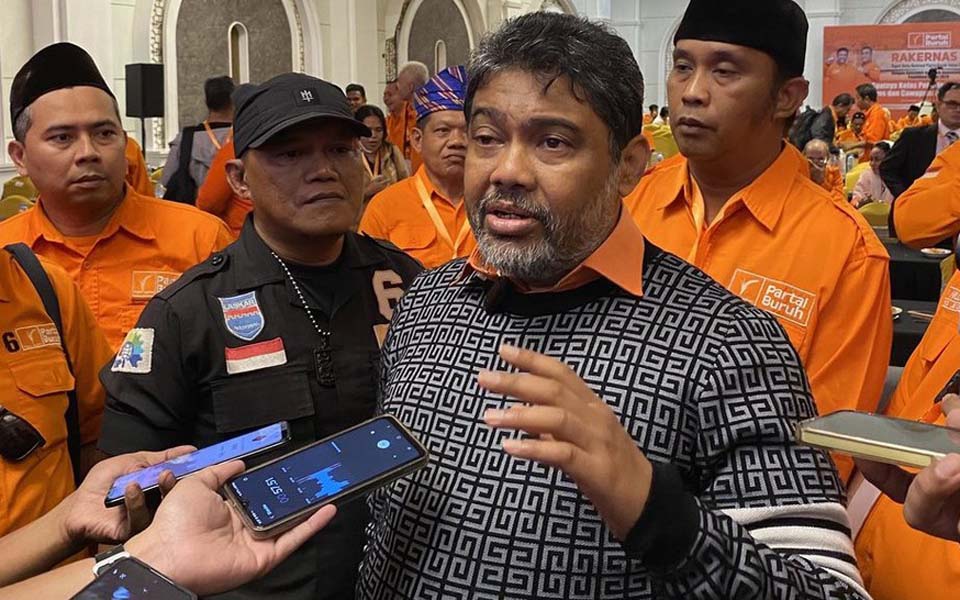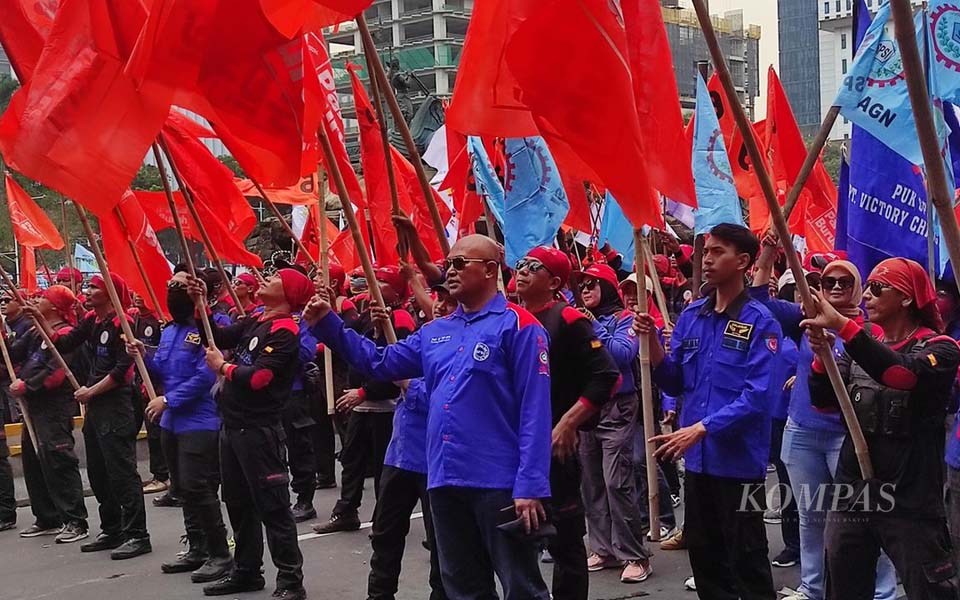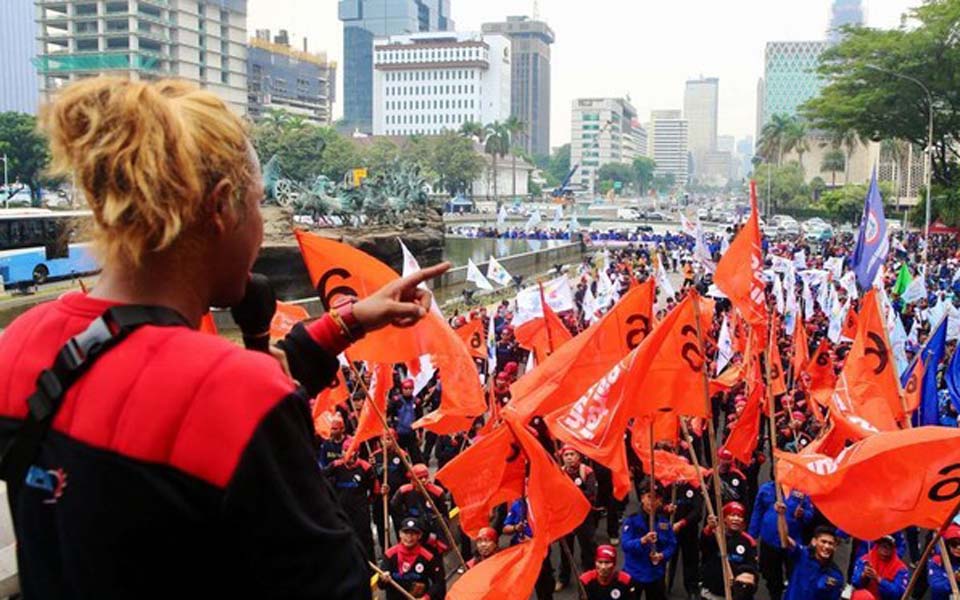Sherr Rinn – The Indonesian Labour Movement (GBI), which is made up of the Indonesian Metal Trade Workers Federation (FSPMI)/Confederation of Indonesian Trade Unions (KSPSI), the Confederation of the All-Indonesian Workers Union (KSPSI), the Confederation of Prosperity Labour Unions (KSBSI), the Indonesian Labour Union Confederation Preparatory Committee (KP-KPBI) and several other trade unions, has just declared that a national strike planned for November 12-20 (eight days) will be put back until November 24-27 (three days).
The reasons for the postponement is because they first need to hold mass meetings on November 12-20, in other words they are not ready yet. Yet the governor will set the minimum wage increase for 2016 on 20 November.
In fact, over the last three years we have been able to see a series of postponements and even cancelations of strikes by the elite leadership of the big trade unions.
2012
The elite leadership of these big trade unions has a record of “playing around” with national strikes, at least since the first successful national strike. The October 3, 2012 national strike which was the first one that was considered extraordinary and a success, was in fact dominated by workers from shift 2 and 3 who do not work in the mornings.
Factory sweep actions contributed to the success of the strike by “fetching” workers still working in the factories. But there were also factories that continued to operate because they were missed out or because they were protected by various means by the capitalists, including by utilising assistance from trade union leaderships.
Following this national strike, the capacity to radicalise workers was paralyzed by the signing of the “harmonisation agreement” on November 8, 2012 by the leader of the Bekasi chapter of the FSPMI, Obon Tabroni, and the leader of the SPSI, Abdullah, with the Indonesia Employers Association (Apindo), the Bekasi regional government and social organisations made up of thugs. The agreement put an end to solidarity actions that were often referred to as “geruduk pabrik” or factory sweeps in Bekasi, which was soon followed by other areas.
2013
In 2013 there was another attempt at organising a national strike. This time by uniting the left trade unions under an alliance called the Labour Movement National Consolidation (KNGB), which was declared in late September 2013 at the Juang Gedung building in Jakarta.
Meanwhile the Indonesian Trade Union Council (MPBI), which was established in 2012 and comprised the Confederation of Indonesian Trade Unions (KSPI), the National Trade Union Confederation (KSN), the Confederation of All Indonesian Workers Union (SPSI) and the Confederation of Prosperity Labour Unions (KSBSI), was deeply fractured with KSPSI leaders Andi Gani and Mudhofir opposing KSPI chairperson Said Iqbal, and threatening to carry out factory sweeps at the declaration of the Untied People’s Movement (GEBRAK) on November 11, also at the Gedung Juang building.
The KNGB national strike, which was planned to take place between October 28 and November 1, 2013, was then postponed until October 31 to November 1. On the first day of the strike hundreds of thugs from pro-employer social organisations attacked tens of thousands of workers injuring at least 17. On the second day the strike was replaced with a unilateral national protest by the KSPI in an action at the national police headquarters in Jakarta over the police’s failure to investigate the violence against workers. Later it was discovered that the FSPMI had unilaterally withdrawn the police report, which was protested by the Jakarta Legal Aid Foundation (LBH Jakarta).
The biggest weakness of the national strike was revealed. Uneasiness developed among workers from small factories, subcontractors and vendors because the big factories did not stop production during the strike. Workers from the FSPMI-SPEE work unit leadership (PUK) at the company PT Plavis for example were sacked because the strike was deemed illegal.
FSPMI/KSPI chairperson Said Iqbal gathered together the leaders of FSPMI trade unions in Tambun, Bekasi, to question them about their commitment to the strike. They were also asked to sign a document to this effect. It was not effective.
Labour politics and economy educator Danial Indrakusuma depicts the consciousness of workers who have experienced the trickery of trade union leaders from the big factories in the following way:
“An open thinking has begun to grow that factory workplace leaders/officials will not in fact stop production. Or that leaders/officials are not setting an example. In the same vein moreover there are big factories which, in fact, could contribute greater numbers of protesters for the sake of winning the struggle”.
Immediately after this defeat, Said Iqbal again promised regional strikes (as an alternative) through instruction Number 012456/org/DPP-FSPMI/XI/2013 which would supposedly be held on November 28-29, 2013 to demand a minimum wage increase in 2014 of 50 percent, health insurance for all Indonesian workers by January 1, 2014, and an end to outsourcing in accordance with Department of Labour and Transmigration Regulation Number 19/2012, the enactment of the Draft Law on Domestic Workers, the removal of Bekasi Police chief Isnaeni Ujiarto and the arrest of the intellectual actors behind the violence against workers.
On November 27 however, the planned regional strikes were postponed until an unspecified date. The strike was replaced with an action at the national police headquarters with the same demands. The regional strikes themselves never took place.
2014
In the struggle over wages in 2014, the KSPI again united with KSPSI and KSBSI, after quite sharp divisions in the 2014 presidential elections where Said Iqbal supported former General Prabowo Subianto while Andi Gani and Mudhofir backed President Joko “Jokowi” Widodo”, who went on to win the presidency.
They made plans for a joint national strike on December 10-11 to demand a wage increase of 30 percent. Once again however, following a meeting of the leaders of the three big labour confederations and scores of other union federations on December 2, the so-called national strike was replaced by a national protest on the grounds that it would be a warm up prior to the national strike. The pretext given was that preparations were insufficient. To this day, the national strike has never gone ahead.
2015
Plans for a national strike were again put forward for May Day 2014 with Said Iqbal in the name of the KSPI announcing a national strike in November if the government failed to fulfill workers’ demands on May Day.
In July, once again the KSPI together with the GBI made plans to hold a national strike opposing a new regulation on old-age benefits (JHT) issued by the Social Security Management Agency (BPJS) that would restrict workers’ access to benefits.
Plans for the national strike became even more animated in the lead up to the setting of the 2016 minimum wage increase, particularly after a discourse emerged about a draft government regulation on wages increases. The new regulation, Government Regulation Number 78/2015, which came into effect on October 23, sets annual wage increases based on the inflation rate and economic growth. Using on this formula, wage increases for 2016 will be set at no more than 11.5 percent.
Despite the momentum and high level of resistance to the new wage regulation, the latest national strike was postponed once again. The preamble to the announcement read: the planned national strike that had earlier been scheduled for November 12-20 (8 days) will be held on November 24-27, 2015 (3 days).
Disappointment
A successful national strike still depends on the will of the leadership of the big trade unions who control large numbers of workers such as the FSPMI/KSPI, KSPSI and KSBSI. The patron-client relationship between the trade union elite and its members means that national strikes are always contingent upon instructions from trade union functionaries, and accompanied by widespread disappointment if these instructions are postponed, canceled or it is unclear when they will be issued.
Moreover, if seen from the organisational composition of the trade unions that make up alliances driven by the KSPI, the collective strength of the majority of workers are in fact congregated within it. This strength is meaningless if it is not honed with a high level of militancy and combativeness. Learning from the experience of the second round of national strikes in 2013, the “harmonization” between the trade union elite and capitalists in the big companies is one of the reasons for the total failure of the national strikes. At any rate, a genuine national strike such as this would put the comfort of a handful of the trade union elite at risk. How is it possible to accommodate both: the comfort of a handful of trade union elite leaders and a struggle to halt production completely? It is of course impossible; you must choose one or the other. The longer this is allowed to continue, large alliances such as this will in fact become an effective magnet in gathering workers strength, particularly with the support of left-wing trade unions that are part of the GBI.
For some time now the trade union elite have tried to cure this disappointment with promises of a new struggle: a national strike sometime in the future, a regional strike or taking part in national and regional elections. This is related because the mass of workers are truly dependent on the policies of their elite leadership and yet to develop a personal identity, so this dissatisfaction has yet to develop in to independent acts of resistance. The working class has also yet to see any trade unions or alterative movements which can offer them some hope so they have yet to change their alliances.
What is currently being tried by the United People’s Committee (KPR) to become an alternative alliance, which at the very least can erode the domination of the big trade unions which often make unilateral policy decisions, is not an easy task. Although it is not part of the GBI, the KPR is offering to “fight together from two separate fronts”.
The labour struggle will more quickly win victories if the majority of workers side with those forces that are most willing to fight.
Solidarity strikes
Strikes are the principal weapon of the working class in fighting for its demands. This is because a strike stops production in factories where the workers are employed thereby resulting in profit losses for the capitalist owners.
Under the Labour Law, the definition of a strike is design to weaken the working class, namely stopping production as a result of failing to find a resolution after three rounds of negotiations which are declared deadlock. A strike is categorised as being a legal or illegal strike. Through various means, the capitalists attempt to manipulate or claim worker’s strikes are illegal so the capitalists can win through legal means.
Under this definition, a national strike is not acknowledged by Indonesian labour laws because this kind of strike has not gone through a process of negotiations with the employers of respective factories. Labour Minister Hanif Dhakiri knows this all too well and has not hesitated in rejecting the legality of national strikes. This issue also shows that he does not side with the working class even though he is a former activist himself.
The consequences of a strike being deemed illegal is no joke, and can result in workers being accused of a serious crimes and workers can be dismissed and thrown into the ranks of the unemployed.
A national strike is not an easy thing, but it is also an extraordinary achievement if it can be done consciously by workers themselves, not because of factory sweeps or just a convoy action of shifts 1 and 2. Simultaneous strikes can also be used as solidarity actions to assist struggling workers in other factories. In map of the supply chain, workers in factories that work to fulfill factory orders for the same customers can very effectively use the tactic of solidarity strikes to hurt these multinational companies.
Workers who are accustomed to enduring factory discipline and adapted to the hegemony of the capitalist state are discouraged by and afraid of bourgeois laws that make national strikes illegal. But for workers who are continually seeking a strategy or solution as to how to be able to completely stop the production process, they will move ahead and democratically organise themselves and their colleagues in grass roots organisations and not be concerned when they are obstructed by their own trade union elites who are fond of playing around with the bluff of a national strike.
The capacity of the working class in developing the tactic of simultaneous or solidarity strikes will be the key to determining the struggle of Indonesian workers in the future.
[The writer is one of the moderators of Solidaritas.net and a member of the Indonesian People’s United Resistance (PPRI) and the KPR. Translated by James Balowski for the Indoleft News Service. The original title of the report was Nasib Mogok Nasional di Tangan Elit Serikat Buruh.]
Source: http://koranpembebasan.org/2015/11/nasib-mogok-nasional-di-tangan-elit-serikat-buruh/















